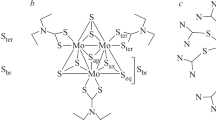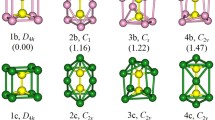Abstract
Variable temperature X-ray diffraction studies were carried out on several μ-imidoyl clusters with the general formula, (μ-H)2 M 3(CO)9-(μ-imidoyl)(X) whereM=Ru or Os,X=Cl, Br, CF3COO, and imidoyl ligand is
or CH3C=NCH2CH3, in order to analyze ligand atom motion in the solid state and to precisely locate the hydride ligands. An initial study on (μ-H)(μ3-η2-CH3C=NCH2CH3)Ru3(CO)8PPh3 indicates that the atomic (thermal) dispersion parameters (ADP) of the μ3-imidoyl ligand atoms can possibly be used to correlate solution ligand fluxionality with ligand-binding forces in the solid-state structures. Difference Fourier analysis techniques were used to locate hydride ligands in several triosmium clusters, and it was observed that if there was a nitrogen atom in the bridging ligand along a metal edge which also contained a hydride bridge then the hydride was asymmetrically bonded (ca. 0.1–0.7 Å) and always closer to the nitrogen bonded metal. In addition, in dihydrido trimetallic clusters, the distance of separation of the two hydride ligands correlates with the tendency of those hydrides to exchange at room temperature. If the angle ϑ, which describes the angle between the planes relating the bridging hydride ligands and the two inclusive metal atoms, is less than about 55 degrees, then the hydrides can undergo site exchange at room temperature on the nmr time scale.
Similar content being viewed by others
References
J. Dunitz, V. Schomaker, and K. Trueblood (1988).J. Phys. Chem. 92, 856–867.
P. Seiler and J. Dunitz (1979).Acta Crystallogr. B35, 2020–2032.
H. Burgi (1989).Acta Crystallogr. B45, 383–390.
C. Brock and J. Dunitz (1982).Acta Crystallogr. B38, 2218–2228.
W. Hummel, A. Raselli, and H. Burgi (1990).Acta Crystallogr. B46, 683–692.
K. Trueblood (1978).Acta Crystallogr. A34, 950–954.
D. Braga and F. Grepioni (1991).Organometallics 10, 1260–1268.
S. Aime, D. Braga, R. Gobetto, F. Grepioni, and A. Orlandi (1991).Inorganic Chem. 30, 951–956.
H. Burgi, A. Raselli, D. Braga, and F. Grepioni (1992).Acta Crystallogr. B48, 428–437.
S. Aime, R. Gobetto, F. Padovan, M. Botta, E. Rosenberg, and R. Gellert (1987).Organometallics 6, 2074–2078.
K. Trueblood (1989). THMA11 thermal vibration analysis computer program. University of California, Los Angeles.
W. Hummel, J. Hauser, and H. Burgi (1990).J. Mol. Graphics 8, 214–220.
G. Orpen (1980).J. Chem. Soc. Dalton Trans. 2509.
M. Day, S. Hajela, K. Hardcastle, T. McPhillips, E. Rosenberg, M. Botta, R. Gobetto, L. Milone, D. Osella, and R. Gellert (1990).Organometallics 9, 913–924.
S. Aime, R. Gobetto, F. Padovan, M. Botta, E. Rosenberg, and R. Gellert (1987).Organometallics 6, 2074–2078.
B. Johnson and R. Benfield,in B. F. Johnson (ed.),Transition Metal Clusters (John Wiley and Sons, U.K., 1980), pp. 471–543.
S. Kabir and E. Rosenberg (unpublished results).
E. Rosenberg (private communication).
Author information
Authors and Affiliations
Rights and permissions
About this article
Cite this article
Hardcastle, K.I., Irving, M. Hydride atom location and atomic dispersion parameter analysis in trimetal clusters using variable temperature X-ray diffraction. J Clust Sci 4, 77–88 (1993). https://doi.org/10.1007/BF01028386
Received:
Issue Date:
DOI: https://doi.org/10.1007/BF01028386




